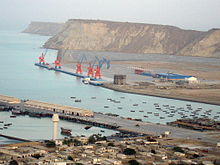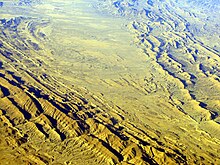Makran
Makran ( Persian مکران, DMG Makrān ), the ancient Gedrosien , is a semi-desert-like region which - today part of Pakistan , half of Iran - extends along the Arabian Sea and is more recently known as (part of) Balochistan .
Surname
The name Makran (also Mukran ) can probably be derived from māhī-ḫurān ("fish eater "). It would be the Persian translation of the term Ichthyophagoi , which the ancient Greeks used for the inhabitants of the Gedrosian coast .
However, there is also a likely connection to Magan , a country with which the early Mesopotamians traded, or to the satrapy Maka known from ancient Persian inscriptions .
Location and geography
Coastal area
The Makran Coast begins in the west, on the Gulf of Oman , around Cape Jask in the Iranian province of Hormozgan , and extends in an easterly direction to around Sonmiani Bay (around 25 kilometers north of Karachi ). Around 650 km of the approximately 1000 km long coastline thus belong to the Pakistani Balochistan Province , the rest to the Iranian Province of Sistan and Balochistan .
Due to its extreme geological and climatic conditions, Makran is only sparsely populated. The predominantly Muslim , Iranian -speaking Baluch population is concentrated in fishing villages and some larger coastal towns. The latter are from west to east Konarak and the free trade zone Tschahbahar in Iran as well as Jiwani , Gwadar , Pasni and Ormara in Pakistan. Of the natural harbors of Tschahbahar, Gwadars and Pasnis, the first two are of great strategic importance for the entire region as their countries' main accesses to the Indian Ocean . These are competing deep-water ports , the expansion of which is being promoted by China and India .
Before Pasni lies the only larger island of Makrans, Astola . In the lagoons and bays that characterize the entire coast, there are partly mangrove forests and nesting sites for several threatened turtle species . In the Pakistani part of the Hingol River lies the Hingol National Park . It was founded in 1997 and, as the largest national park in the country, covers a total area of approximately 6100 km².
inland
Apart from the mostly narrow coastal strip, Makran is a difficult to access highland with an arid climate and several 150–220 km east-west mountain ranges , the three largest of which are the up to 1578 m high, also called Talar-e Band called the coastal macran, the up to 2286 m high central macran and the up to 2060 m high Siyahan mountain range. The former is separated from the latter by the fertile Ketch Valley with the urban center of Turbat , and the latter is separated from the latter by the Rachschan-Maschkel Valley, in which rice , dates and grain are grown. The most important rivers besides the ketch are called Djagin, Gabrig, Sadetsch, Raptsch, Sarbaz and Nahang . In the Iranian part, immediately east of Basch (a) kard (Baschgerd), the Makran Mountains rise to 2093 m and drop into the Jaz-Muriyan Depression. The Siyahan chain (near Saravan) can be seen as the northern border of Makran; This is where the historical regions of Turan and Sarhadd (in the south of Sistan) are connected, while Kirman in the west and Sind in the east .
The larger inland cities are today, with the exception of Turbat, in the Iranian part of Makran: Above all, Nikschahr (formerly Geh), Bampur and Irānschahr (formerly Fahraj), the capital of the eponymous Schahrestan, are to be mentioned . The main tribes (the Baluch) that inhabit the Makran Mountains today are the Gitschki, Buledi, Hot, Bizendscho, Nouschervani, Mirwari, Rind, Rais, Landi, Kattawar, Kenagizay, Mullazay, Schirani, Mubaraki, Laschari, Ahurani, Jadgal and Sardarzay.
history
On the Makran coast, two ancient Harappa settlements were found in Sutkagen-dor (near Dschiwani on Dascht-Kaur) and Sochte-Koh (near Pasni on Schadi-Kaur) . The archaeological sites show that it was probably between 2500 and 1800 BC. There was trade between cities of Harappas, Sumers and the Gulf region . Makran was later conquered by the Achaemenid king Cyrus II (559-530). The capital of the Persian satrapy was Pura , which is probably identical to Bampur, forty kilometers west of Iranshahr. While his admiral Nearchus was sailing along the coast, Alexander the Great marched after his devastating Indian campaign in 325 BC. Through the desert of Makrans, which was then known as Gedrosia , and lost a large part of its soldiers; The same thing happened to the last Khorezm Shah Jalal ad-Din in 1224 AD .
In post-Christian times Makran was a (Sakastan / Sistan subordinate) province of the Sassanid Empire , which stretched from Tiz (see below) and Fahrajj to Daibul at the mouth of the Indus ; It is said of Shah Narseh that a "king Makrans" paid homage to him when he ascended the throne (293). The Islamic conquest of Makran, up to which the country was under the cultural and religious influence of India, took place under Umar ibn al-Chattab (c. 644) and Muawiya I (expedition Ziyad ibn Abihis) from Kirman, but the area preserved one extensive autonomy, which hardly any foreign ruler could (and wanted) change in the following centuries. As the fringe province of the Umayyad Empire , the region served as the starting point for Muhammad ibn al-Qasim's advance into neighboring Sind in 711 .
At the time of the Abbasids , Makran's main port city of Tiz ( Ptolemy ' Tesa ; the ruins are a few kilometers north of Tschahbahar) developed into a booming center in maritime trade between the Persian Gulf and India (which became even stronger with the decline of Hormuz in the 12th century should tighten). The city, which was initially officially administered from Kirman, was then inhabited by people of very different origins, most of whom were still non-Muslims. According to al-Muqaddasi , Tiz was surrounded by palm groves and owned a magnificent mosque in addition to large department stores . In general, however, the politically relatively insignificant Makran is described by medieval geographers as barely and sparsely populated, the main product of the region was sugar cane . The cities that are mentioned (but hardly described) include, besides Tiz: the capital Fannazbur (today Pandschgur), the ruler's seat Kidsch (today Ketsch), Bampur and Fahradsch (today Iranschahr), Qasarqand, Jalk, Dazak, Chwasch (today Gwascht), Rask as well as Armabil and Qanbali on the coast.
Around the end of the 9th century Makran seems to have been a stronghold of the Kharijites who sought refuge in the remote province. From the 10th century, the local dynasty of the Maʿdānids ruled here, whose ruler resided in Kidsch and called himself Maharajah . After the Maʿdānids under ʿIsā ibn Maʿdān initially became vassals of the Saffarids and were threatened in 970-72 by the Buyids Adud ad-Daula , who advanced to Westmakran and against Tiz , they became in the second half of the 10th century (probably shortly after 976 / 77) the Ghaznavids tributary whose Sultan Mahmud could interfere in succession disputes 1025-26. The end of the Maʿdāniden came when Mahmud's son, Sultan Masud I , sent a punitive expedition (under Yusuf ibn Sebüktegin ) to Kidsch in 1030, captured the city and made Abu 'l-ʿAskar a favorite to make Makran's regent. The Ghaznavids then seem to have controlled the region until the Ghurids came to power. Under Qawurd , Makran fell to the Kirman Seljuks in the 11th century , before it first belonged to the empire of the Khorezm Shahs in the 13th century and was then invaded by the Mongols under Chagatai . A little later, Marco Polo sailed along the Makran coast, which he called Kesmacoran ("Ketch Makran"), counted as part of India and by no means described as poor in terms of trade and agriculture. The ruler of the country, which was then increasingly populated by Persian Baluch, is said to have ruled from ketch as before.
After, according to Ibn Battuta, in the early 14th century a certain Malik Dinar had used the death of the Ilkhan Abu Said (1335) to gain control of Makran, the area was ruled by the Mughals from the 15th century . Later it belonged temporarily to the British Empire , was ruled alternately by native Zikri families, the Iranian Qajars and as a sultanate. After the emergence of Pakistan (1947), the eastern Makran, which at that time was still part of the princely state of Kalat, was divided into a district of the Balochistan Province and later several times into smaller administrative areas. The border between the Iranian Makran and the first British, then Pakistani Baluchistan Province was established by the Anglo-Persian Border Commission in 1870–72.
Individual evidence
- ↑ cf. Article in the EIr and on Livius.org
- ↑ cf. Article on Livius.org
- ↑ Sanjeev Miglani: India, China's rivalry and a tale of two ports , Reuters 25 March, 2011
- ↑ Pakistan wants a Chinese naval base on its territory
- ↑ Hingol National Park on Wildlife of Pakistan
- ↑ cf. Article on Livy
- ↑ see article in the EIr and article on Livius
- ↑ Guy Le Strange, p. 329 f.
Literature and web links
- Thomas Holdich: Article "Notes on Ancient and Mediaeval Makran" in: Geographical Journal 7, 1896
- Clifford Edmund Bosworth: Article “Makrān” in: Encyclopaedia of Islam , New Edition (ed. By PJ Bearman et al.), Leiden 1960–2004
- Stephen Pastner: Conservatism and Change in a Desert Feudalism: The Case of Southern Baluchistan. In: Wolfgang Weissleder (Ed.): The Nomadic Alternative. Modes and Models of Interaction in the African-Asian Deserts and Steppes. Mouton Publishers, Den Haag / Paris 1978, pp. 247-260
- Guy Le Strange: The Lands of the Eastern Caliphate - Mesopotamia, Persia and Central Asia from the Moslem Conquest to the Time of Timur , Cambridge 1905
- Clifford Edmund Bosworth: Article “Makrān” (February 11, 2011) in: Encyclopaedia Iranica , Online Edition
- Article about Gedrosia on Livius.org
Coordinates: 25 ° N , 61 ° E






